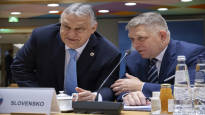The Prime Minister of Slovakia, Robert Fico, is a left-wing populist, but his national-conservative world of values differs from the value-liberal social democracy we are used to in the West.
was published last Thursday by the Prime Minister of Slovakia Robert Ficon a story related to the shooting that sparked a debate about whether the prime minister and his Smer party can be characterized as right-wing or left-wing populists.
The question cannot be answered without understanding the political history of Eastern Europe after the Cold War, says a researcher familiar with the history of European ideas and politics.
– I wouldn’t call Fico a right-wing populist myself, academy researcher at the University of Helsinki Timo Miettinen states.
In this story, we tell you what unites and separates right-wing and left-wing populist movements in Europe.
In the countries of the former Eastern Bloc, right-wing and left-wing politics were defined after the end of the Cold War by the attitude towards the tradition of communism and economic reforms.
Fico succeeded in the early 2000s by opposing right-wing or “neoliberal” reforms that were carried out in Slovakia after the end of communism, says Miettinen.
– He managed to unite the left-wing remnants of the communist parties into one big party. It was essential that Fico got the support of the trade unions behind him, says Miettinen.
Common scapegoat
In Eastern European countries, left-wing populism is therefore very strongly built on the ruins of communist parties. On the other hand, according to Miettinen, left-wing populism in Western Europe is a modern movement whose background is based on experiences from the times of military dictatorships. Several western left-wing populist movements are characterized, for example, by value-liberal politics.
– In many issues of values, Fico’s line is nationally conservative. This is quite a different type of politics than, for example, the social democratic parties of Western Europe pursue.
Fico has been described, among other things, at EU tables by Hungary’s right-wing populist prime minister Viktor Orbán To a pro-Russian soul tribe member.
Immediately after taking office last October, Fico announced that Slovakia’s arms aid to Ukraine would end. Like Orbán, he has also opposed sanctions against Russia.
Both support strict restrictions on immigration and oppose legal reforms that improve the rights of sexual and gender minorities. In the EU, during Fico’s recent term as Prime Minister, there has been concern that Slovakia will slip into Hungary’s path in terms of the rule of law and freedom of the press.
According to Miettinen, various right-wing and left-wing populist movements in Europe are united by the rhetoric of pursuing the national interest.
– The radical left and the right are often united by the fact that the EU is a certain kind of scapegoat for both, says Miettinen.
The extreme right is expected to win the European elections
Miettinen points out that the left-wing populist movements are very different from each other, as they are influenced by different national histories.
For example, in Greece, the Syriza party came to power in 2015, fueled by the euro crisis, with a radical program that pushed, among other things, Greece’s exit from the euro system.
Syriza is a much more liberal party than Slovakia’s Smer, and in February, among other things, it voted in favor of an equal marriage law in the Greek parliament.
in Germany Sahra Wagenknecht founded, separated from the German left BSW party push for socialist reforms and limiting immigration. The party opposes the sale of weapons to warring countries, such as Saudi Arabia, but also to Ukraine.
In addition, the party opposes the military alliance NATO as an “actor destabilizing world peace” and sanctions against Russia.
– If there is one thing that unites Europe’s left-wing populist movements, it is perhaps opposition to very strong market liberalism. Otherwise, the shops do not have a common vision or a shared value base, says Miettinen.
There is no obvious home for left-wing populist movements in the European Parliament either, says Miettinen.
For example, the German Left Party and Syriza belong to the left-wing GUE-NGL grouping in the EU Parliament. This group also includes the Finnish Left Federation.
Smer, on the other hand, belonged to the European Social Democratic Party until October 2023. It was separated from the group after Fico won the Slovak parliamentary elections.
Based on opinion polls, the national conservative and far-right parties are significantly increasing their seats in the European Parliament in the June elections.
– The situation after the Eurocrisis and poverty increased the support of left-wing populists. Now, the increase in costs caused by Russia’s war of aggression is strengthening right-wing populist forces, says Miettinen.
Also listen to:
